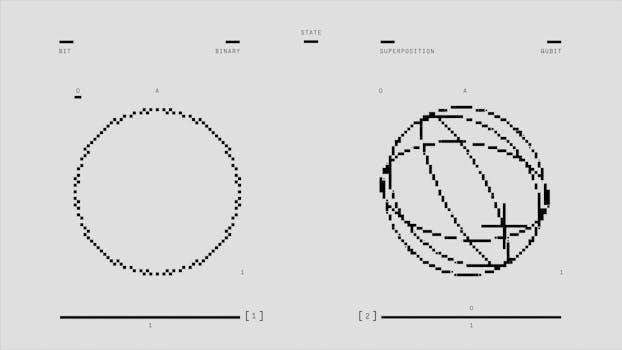Conceptual Physics PDF⁚ An Overview
The study of conceptual physics, often accessed through PDF documents, is a method that emphasizes comprehension of physics concepts over complex mathematical calculations. These PDFs, frequently based on Paul G. Hewitt’s work, offer a clear and illustrative approach to learning.
Conceptual physics, as a field, focuses on understanding the core ideas of physics rather than intricate mathematical manipulations. This approach, often embodied in PDF textbooks, is designed to make physics accessible to a wider audience, including those who might not have a strong mathematical background. The emphasis is placed on the qualitative aspects of physics, exploring the ‘why’ behind phenomena rather than just the ‘how’. It aims to build a strong foundation of conceptual understanding which serves as a stepping stone for further, more mathematically-oriented studies. It uses real world examples and thought experiments to convey the complex ideas. The core idea of conceptual physics is to foster an intuitive grasp of physics principles, enabling students to apply these principles in diverse scenarios without becoming bogged down by complex calculations. This introduction is often the first step for many individuals into the world of physics.
Paul G. Hewitt’s Approach
Paul G. Hewitt is widely recognized for his unique approach to teaching physics through his conceptual physics materials, often found in PDF format. Hewitt’s method is characterized by its emphasis on clear, concise language, avoiding unnecessary jargon and complex mathematical formulas. He uses simple, everyday examples and engaging cartoon-style illustrations to explain challenging concepts, making physics relatable and understandable. His approach focuses on building a strong intuitive understanding of physical principles, encouraging students to think critically and visualize phenomena rather than simply memorizing equations. Hewitt’s teaching style is designed to make physics accessible and enjoyable for all students, regardless of their prior math skills. This method has made his resources a popular choice for educators and learners alike, evident in the widespread availability of his work in PDF formats. His method prioritizes understanding the “why” over the “how.”

Key Concepts in Conceptual Physics
Conceptual physics focuses on core ideas like motion, energy, and forces, with emphasis on understanding principles rather than numerical problem-solving. Visual aids support learning, making abstract ideas more accessible.
Fundamental Principles
At the heart of conceptual physics lies a commitment to understanding the basic laws governing the universe. These fundamental principles, often presented in accessible formats like PDFs, provide a framework for grasping how the physical world operates. The emphasis is on building a solid understanding of concepts rather than getting lost in mathematical complexity. This involves exploring ideas like Newton’s laws of motion, the conservation of energy, and the nature of waves and light. Visual aids and simple language are key tools in conveying these principles. The goal is to make these ideas intuitive, allowing students to apply them to everyday situations and develop a deep appreciation for the elegance of physics. The approach prioritizes qualitative understanding, ensuring that students grasp the underlying concepts. This approach sets conceptual physics apart from more traditional, mathematically-focused courses.
The Role of Visual Aids
Visual aids are integral to the study of conceptual physics, particularly within PDF resources. Diagrams, sketches, and illustrations transform abstract ideas into tangible concepts, making physics more accessible to a wider range of learners. Paul G. Hewitt’s work is renowned for its effective use of cartoon-like drawings to explain complex phenomena. These visual tools help to break down difficult concepts into smaller, more understandable parts, enhancing comprehension and retention. They also cater to different learning styles, making the subject engaging for students who might struggle with purely textual explanations. The use of visual examples makes the learning process more intuitive and less intimidating. Through these aids, the often-challenging world of physics is presented in a more approachable way. This methodology underscores the importance of visual learning in mastering physics concepts, especially when using PDF formats for study.

Textbook Editions and Availability
Conceptual Physics has several editions, including the 11th and 12th, often available in PDF format. These digital versions provide access to learning materials, sometimes through digital libraries or educational platforms.
11th and 12th Editions
The 11th and 12th editions of Conceptual Physics by Paul G. Hewitt represent significant iterations in the textbook’s development, building upon the foundation of conceptual understanding that has made the book so popular. The 11th edition continues the tradition of presenting physics principles through clear language and engaging visuals, while the 12th edition further refines this approach, incorporating contemporary examples and updated research findings. Both versions are designed to cater to a wide range of learners, from those with minimal science backgrounds to those seeking a strong foundation for more advanced study. These editions often feature updated problem sets and interactive resources, enhancing the learning experience. Many students and educators prefer these versions for their comprehensive coverage of fundamental physics concepts and their accessibility. The 12th edition, in particular, is often sought after for its latest information and improved pedagogical techniques. Both editions are commonly available in various formats, including PDF, which facilitates convenient and affordable access for many students.
PDF Formats and Access
The availability of Conceptual Physics in PDF format has transformed how many students access and engage with the material. These digital versions offer a convenient and often more affordable alternative to traditional textbooks. PDF files allow for easy searching, highlighting, and annotation, enhancing the learning process. Access to Conceptual Physics PDFs can vary, with some available through educational platforms, university resources, or online retailers. While some PDFs may be legally shared, others are subject to copyright protection, requiring a purchase or institutional access. Due to copyright concerns, there have been instances of DMCA takedowns of unauthorized PDF versions online. Students should be mindful of these issues and seek legitimate avenues for obtaining the PDF. Some publishers may offer digital versions through their websites or educational platforms, ensuring access to updated content. The convenience of digital formats has significantly broadened the reach of conceptual physics education.

Application and Learning
Conceptual physics, through its accessible PDF format, is widely used in education, catering to diverse learning levels and styles. It provides a solid understanding of physics principles which is very important for every student.
Use in Physics Education
Conceptual physics, often available in PDF format, plays a crucial role in physics education across various levels. Its emphasis on understanding concepts, rather than just mathematical formulas, makes it an invaluable resource for students. The approach, pioneered by Paul G. Hewitt, uses simple language and illustrative sketches to convey complex ideas clearly. This method is especially helpful for those who might find traditional physics textbooks daunting. The use of PDF documents allows for easy access and distribution of these materials, making conceptual physics more available to students and educators alike. Furthermore, many educators find the conceptual physics approach excellent for introductory courses, as it lays a strong foundation for further studies in physics. This approach helps students develop a deeper intuitive grasp of physical principles, fostering more effective learning and retention. The integration of visual aids and real-world examples further enhances the learning experience. Conceptual physics, thus, serves as a cornerstone in fostering a genuine appreciation for physics.
Relevance for Different Levels

Conceptual physics, particularly in PDF format, demonstrates remarkable relevance across diverse educational levels. For introductory physics learners, it provides a less intimidating entry point, focusing on understanding core principles before delving into complex calculations. The clear explanations and visual aids make it suitable for high school students and those in early college courses. Moreover, conceptual physics is beneficial for non-science majors seeking a basic understanding of the physical world. Its intuitive approach ensures that fundamental concepts are accessible to a broad audience. Even for advanced students, reviewing conceptual physics can solidify their foundational knowledge and offer fresh perspectives on familiar topics. The adaptability of conceptual physics makes it an invaluable resource for educators and students regardless of their academic level or specific focus. The use of PDF format further enhances its convenience, allowing easy access for varied learning environments and requirements. Ultimately, this approach bridges gaps and promotes broader understanding across all levels of physics education.
